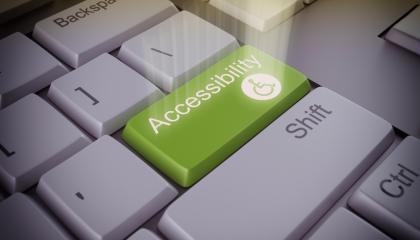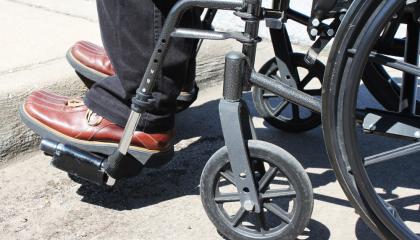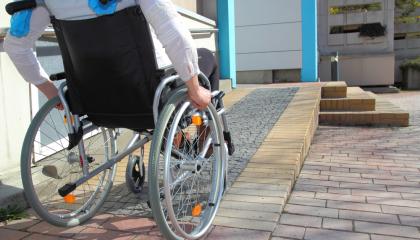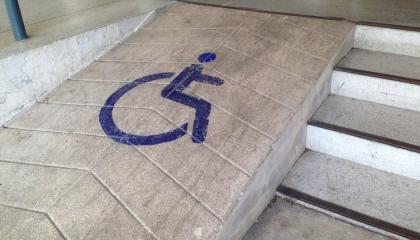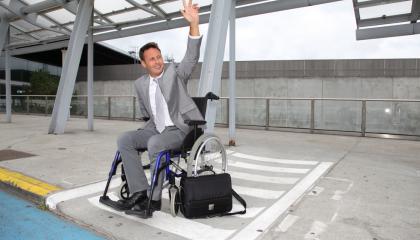When enhancing accessibility in your business, it is important to think about both physical and digital worlds. Your business follows ADA guidelines to create accessible sidewalks and public spaces for those with disabilities that limit mobility, and similar guidelines exist for digital content to serve individuals with vision and hearing impairments. This post will take you through those guidelines and what steps you can take to meet them.
A sidewalk without a curb ramp presents a dangerous decision to a person who uses a wheelchair or a similar mobility device. Without a curb ramp, a person could lose their balance while trying to navigate the sidewalk curb or opt to use the road to avoid the curb altogether, risking an accident with vehicle drivers.
No one should have to make this decision.
A curb ramp allows individuals with impairments to merge safely from a curbed sidewalk to the street and back again. This short ramp makes the world accessible to anyone with a mobility device.
The etiquette of interacting with a wheelchair user is rather simple if we make it so. From an early age, we learn our society’s rules for interacting with one another; however, society doesn’t offer clear-cut standards for interacting with people who use wheelchairs. When meeting a person using a mobility device in public or social situations, some people might freeze up, act in a patronizing way, or ignore the person completely.
People are people—no matter what.
On Monday, March 18th, Google Doodle featured the Japanese inventor of detectable dome tiles, Seiichi Miyake. His invention changed the world by empowering and protecting individuals with visual impairments to cross streets with greater ease. Fifty-two years have passed since the first dome tiles were installed, and these detectable warning tiles are now part of many cities throughout the world.
ADA compliance for temporary events is just as important as ADA compliance for public areas and private businesses. The Americans with Disabilities Act (ADA) prevents discrimination towards individuals with vision loss, hearing issues, and other disabilities. When it comes to accessibility, the ADA outlines certain standards to ensure that public areas, even temporary events, are accessible to people with impairments.
Cities offer a wealth of opportunities, both in terms of jobs and accessibility. However, some of those same cities don’t have easily accessible sidewalks, transportation, or office buildings. Although there have been great improvements in accessibility, some cities still have many steps they can take to be more livable and convenient. With the creation of the Americans with Disabilities Act (ADA), many cities are obligated to add detectable warning tiles to their sidewalks and curb cutouts.
To be as successful as you can in your business, you want to make sure you serve all customers you can. The Americans with Disabilities Act, which became law in 1990, established a set of standards for society, businesses, and public areas that cater to the needs of people with disabilities. While the law sets minimum requirements, companies can (and should) go above and beyond to ensure that people with disabilities feel welcome.
Life’s tough. For those who live with disabilities, life can be tougher. Sometimes it can be difficult to envision how everyday situations and interactions can be even more complicated for people who live with low or no vision. Here are a few of the most common issues that people with impairments deal with on a daily basis.
The Americans with Disabilities Act (ADA) expects workplaces and public areas to be accessible for people with disabilities. Since 1990, businesses and communities strive to meet these requirements. For example, public areas must take steps to remove barriers and add domed-tile curb ramps to improve accessibility and safety for people with impairments. Buildings constructed before 1990 must make adjustments, but buildings built after 1990 must be ADA compliant.
Creating a world that is accessible to everyone, with or without disabilities, takes innovation and drive. Conferences highlight emerging technologies in order to enhance the lives of people living with impairments. These conferences are the perfect platform for cities and businesses to learn how to become more accessible to everyone. Attend one of the conferences below to find out what’s on the horizon for assistive digital technologies, education, and city accessibility.
When the United States passed the Air Carrier Access Act (ACAA), it became illegal for airlines to discriminate against passengers who had an impairment. The law applies to any airline that provides air transportation to, from, or within the United States. Not only does this law cut down on discrimination, but it also requires airlines to provide assistance for passengers, such as a wheelchair, guided assistance for all areas of boarding, or seating accommodation.
Cities and businesses are scrutinizing pedestrian walkways to determine how to best increase the ADA compliance of public spaces. ADA compliant sidewalks make businesses and public areas more accessible to individuals with disabilities. A key component of an ADA compliant sidewalk is the truncated dome tiles that warn pedestrians of a change in the sidewalk, whether an intersection or a ramp.
These truncated dome tiles have two common ways of being installed: cast-in-place or surface-applied.
Pagination
Connect with us
We pride ourselves on our customer service, and we'd love to hear from you! Sign up for our newsletter to keep up with industry updates and trends, as well as any new product releases.



